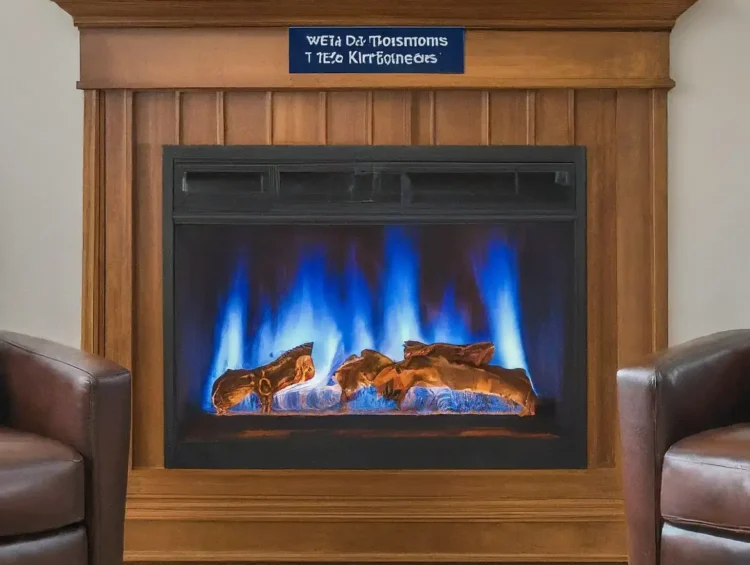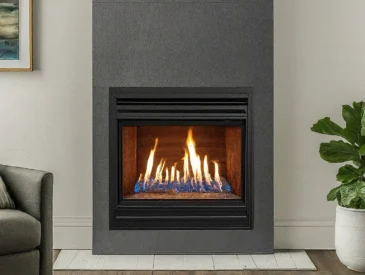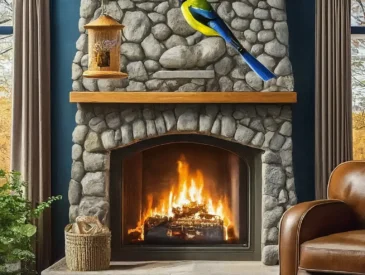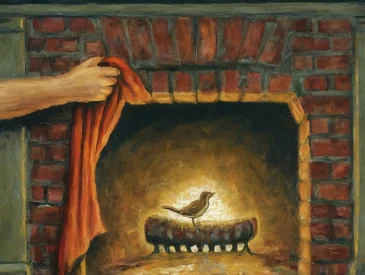If you own a gas fireplace, you’ve probably noticed that the flames tend to burn blue. While many expect fires to have an orange hue, you might wonder: Why do gas fireplaces produce a blue flame?
The reason lies in the fact that gas fireplaces operate at higher temperatures compared to traditional yellow and orange flames.
These blue flames indicate safe operation and signify that your gas fireplace is functioning correctly. Should you wish to revert to the traditional orange flame, you can do so by adjusting the airflow of your fireplace.
In this article, we will delve into the reasons behind the blue flames in gas fireplaces and why they are considered a mark of safety.
Additionally, we will discuss methods to revert to the more conventional orange flame, as well as explore other potential colors that may manifest in your gas-powered flames.
Why do gas fireplaces produce blue flames?
Gas fireplaces produce blue flames due to their higher operating temperatures compared to the typical orange and yellow flames. When a substance burns at approximately 3600 degrees Fahrenheit,
the flame takes on a blue hue. Blue flames, whether generated by propane or natural gas, burn at temperatures around 3,600 degrees Fahrenheit, whereas orange and yellow flames burn at lower temperatures, approximately 2,550 degrees Fahrenheit or less.
The blue flame indicates proper combustion within your fireplace. It will manifest as a blue flame with a lighter blue triangle at its center and a small yellow tip. Therefore, if you own a gas-powered fireplace, observing blue flames is a positive sign of a healthy fire.
Now that we’ve covered the basics of why gas fireplaces produce blue flames, let’s discuss what these flames signify.
Generally speaking, blue flames indicate the following:
Your fireplace is generating the right amount of heat.
Your fireplace is undergoing combustion as it should.
Your fireplace is consuming the appropriate amount of fuel, whether that be natural gas or liquid propane gas (LPG).
Your Gas Fireplace Efficiently Generates Heat
One key reason for the blue flames in gas fireplaces is the generation of significantly higher heat. As previously mentioned, a flame turns blue at around 3600 degrees Fahrenheit, demonstrating that your flame burns much hotter than that of a typical fireplace.
The specific temperature at which blue flames burn efficiently depends on the type of gas your fireplace utilizes, be it liquid propane gas or natural/methane gas:
Blue flames from natural gas burn at around 3,560 degrees Fahrenheit (1,960 degrees Celsius).
Blue flames from propane gas burn at around 3,600 degrees Fahrenheit (1,980 degrees Celsius).
In contrast, yellow and orange flames burn between 1,800 and 2,600 degrees Fahrenheit (982 and 1,426 degrees Celsius).
Your Gas Fireplace Combusts Correctly
Blue or darkly-colored flames serve as an additional indication that a gas fireplace is undergoing proper combustion, which is essential for complete combustion to occur between the air and the gas fuel source.
If you observe a flame inside your furnace that deviates from blue, it suggests a potential wastage of gas and, consequently, your financial resources.
Your Gas Fireplace Utilizes the Appropriate Amount of Fuel
A blue flame within a gas fireplace signifies that combustion is taking place with the minimal amount of fuel required.
If your fireplace exhibits blue flames, you’ve successfully set up your gas fireplace. If the flames do not appear blue, read on for information regarding potential flame colors and their implications.
Is a blue flame safe?
Blue flames are a safety indicator, signifying that your gas fireplace is efficiently generating heat, using the correct fuel quantity, and undergoing combustion as intended. Therefore, observing blue or violet-colored flames assures you that your gas fireplace is operating as it should.
In contrast, if you spot a flame with a lighter coloration (red, green, or yellow), it may indicate an issue with your gas fireplace, resulting in reduced heat production. It’s worth noting that seeing blue flames is not unusual, even with your other household appliances.
Does a blue flame indicate carbon monoxide?
Since blue flames indicate that your gas-powered appliance is functioning correctly, they do not imply the presence of carbon monoxide. Blue flames minimize the risk of exposure to harmful carbon monoxide, while dark flames signify a healthy fire through complete combustion.
What color should a gas flame be?

Ideally, a gas fireplace should burn with a blue flame, indicating that complete combustion is occurring—a balance of the right amount of gas and oxygen being released from the burner.
Any deviation from this blue hue could suggest incomplete combustion, leading to less efficient combustion and lower flame temperatures.
A lighter color, such as yellow, red, or green, indicates potential issues, such as incomplete combustion, which equates to a waste of fuel.
Why is my gas flame not blue?
If the flame in your gas fireplace lacks a blue hue, it may be due to an incorrect fuel-to-air ratio. A yellow flame often indicates that the burner is not receiving enough air for the complete combustion of the gas,
whether liquid propane or natural gas. Non-blue flames can also be a symptom of a dirty burner that requires cleaning.
To rectify this, you can adjust your fireplace burner’s air shutter to allow for more air intake or clean the burner. Cleaning involves removing the access cover and using a vacuum or compressed air canister to remove any soot or deposits.
Additionally, check the ignition fix and thermocouple for carbon buildup. It is recommended to clean your gas fireplace monthly to prevent dust and dirt buildup, even during periods of infrequent use.
Can you adjust the flame color on a gas fireplace?
Depending on your fireplace model, you can alter the flame color from blue to the more traditional orange by adjusting the airflow. Specifically, you’ll need to reduce the airflow to achieve the desired flame color.
How Do You Adjust the Flame Color on a Gas Fireplace?
You can adjust a fireplace’s flame color by manipulating the airflow to the appliance. To shift from blue to orange, intentionally reduce the amount of air your fireplace receives.
The method for adjusting the flame color depends on the specific fireplace model and how the installer initially configured the air shutter. However, there is a general approach to follow:
1. Locate the Air Shutter on Your Gas Fireplace
If your fireplace has glass doors, the adjustable shutters are likely located beneath the doors. For open-front fireplaces, the air shutter is usually situated on the gas line supplying the burner. Remove the protective plate covering the area, if necessary.
2. Identify the Valve Screw(s)
Locate the valve screw or screws. There should be a valve cover with small holes (controlling the air intake) and corresponding screws securing the cover in place.
3. Loosen the Valve Screw(s)
Loosen the screw(s) to enable adjustment of the valve and airflow intake.
4. Ignite the Fire
Conduct a test run to ensure the flame color meets your preferences before resealing your gas fireplace. Light a fire and adjust the valve until you achieve your desired flame color. Remember to replace the air shutter panel.
What flame colors can a gas fireplace have?
While blue is the typical hue for gas fireplace flames, other colors may also manifest. Yellow and orange are common, but you might observe red, purple, and even green flames.
Flame colors divergent from blue or deep violet may suggest issues related to airflow or other potential problems.
Explore various flame colors for aesthetic purposes or to enhance the ambiance of your gas fireplace. Here’s a breakdown of different flame colors and what they might signify:
Blue Flames: Normal Operation: Blue flames indicate a well-functioning gas fireplace. They signify that the combustion process is efficient and the fuel is burning cleanly.
Yellow and Orange Flames: Incomplete Combustion: Yellow or orange flames may suggest incomplete combustion, often caused by a lack of oxygen. This might be due to issues with the air intake or improper fuel-to-air ratios. Regular maintenance and cleaning can help resolve these concerns.
Red Flames: Incomplete Combustion or Gas Type: If your gas fireplace exhibits red flames, it could be a sign of incomplete combustion, similar to yellow or orange flames. However, it’s essential to consider the type of gas being used, as certain additives can contribute to red hues. Consult your fireplace manual or a professional if you’re unsure.
Purple Flames Metal Additives: Purple flames might occur when certain metals or metal salts are present in the fuel. While it can be visually striking, it’s crucial to understand the source of these additives, as some materials may not be suitable for your fireplace.
Green Flames: Copper Content: Green flames can result from the presence of copper in the fuel. Some gas fireplace logs or additives contain copper compounds that produce a greenish hue when burned. Like purple flames, it’s essential to verify the compatibility of these materials with your fireplace system.
If you notice flame colors significantly different from the usual blue, it’s advisable to address the potential issues promptly. Regular professional inspections and cleaning can ensure the optimal performance of your gas fireplace and maintain both safety and efficiency.
conclusion, while blue flames are the norm for a properly functioning gas fireplace, the presence of other colors can be intentional for decorative purposes or indicative of specific issues.
Understanding the potential meanings behind different flame colors allows you to enjoy a safe and visually appealing fireplace experience. Always consult with a qualified technician if you have concerns about the operation of your gas fireplace.





